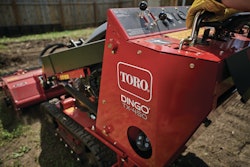The rammer’s versatile footprint makes it the get-in, do-the-job, get-out machine for confined areas and small trenches. In addition, it plays back up to rollers, compacting edges larger machines can’t reach.
Rammers have two types of compactive force: impact, or the weight of the unit pounding down on the soil; and vibration, created by the 500 to 800 blows per minute these machines produce. This combination makes rammers multitaskers, able to compact both granular and cohesive soils.
Your choice
Rammers are differentiated by the type of engine used: two-stroke gas, four-stroke gas, or diesel. Each has its advantages and disadvantages.
Two-stroke gas: Wacker alone manufactures this type. The company promotes its purpose-designed engines, an oil-injection system that eliminates oil and gas pre-mixing requirements, forward travel speed due to better machine balance and the ability to be used in severe angle positions. Detractors say it’s less fuel efficient and emits higher sound levels.
Four-stroke gas: Advocates promote this unit’s fuel efficiency, lighter weight when compared with diesel and the fact there’s no need to mix oil and gas as with older two-stroke units. In the past, four-strokes could not be laid on their sides, but that problem has been eliminated. Four-strokes, however, have less amplitude than a two-stroke unit.
Diesel: Advantages include single fuel sourcing on all-diesel jobsites, a heavier weight that lets it tackle bigger jobs, and the fact it can be used where a spark-ignited machine is prohibited (i.e., mines and refineries).
It does, however, have a more complicated engine, uses costlier fuel in today’s market and has a higher initial cost than other rammer types.
Rammers can range from just over 100 pounds to more than 200 pounds, and be between 2.5 and 4 horsepower. Contractors may choose lighter rammers – which produce less impact force – because they want a unit their crews can easily lift in and out of trucks. Others opt for heavier, higher stroke units designed for bigger jobs.
And U.S. contractors are benefitting from already enacted European hand-arm vibration regulations since rammer manufacturers tend to make one machine for a worldwide market.
Avoid use-and-abuse treatment
Since rammers cost roughly between $1,800 and $5,000, some may view them as use-them-and-abuse-them units. But with attention to care their life can be greatly extended – there are reports of 10-year-old machines although a 3-to-5-year life span is more common.
Service intervals, usually done every 100 hours, require the usual oil and filter change outs. But don’t wait until the interval is closing in – these units need daily oil level and filter checks. Extremely dusty conditions may require cleaning the prefilter more often. Also look for loose hardware and if oil has contaminated the percussion system.
Easy on the operation
Give rammers time to warm up in the idle position for about a minute, longer if in a colder climate. And let the machine do the work for you. There should be little need to manhandle the direction it goes – instead, stand behind it and guide it. Get a feel for how the machine operates when you start to reach compaction, and move on to a new area. If you start to over compact, all the compactive force will go back up into the rammer, lessening its life.
To save on shoe wear, make sure the shoe hits the ground flat and not on its toe or heel.
What’s your shoe size?
Since rammers are essentially single-purpose machines, options usually center on shoe size, material and configuration. Shoes can range in width from 4 to 13 inches, depending on the trench width to be compacted. In addition, extension shoes can help operators still keep the machine waist high when operating in tight trenches. Typical shoe materials include plastic, all-steel and laminated wood sandwiched between two pieces of steel.
Beyond shoes, most manufacturers offer some type of transport cart or wheel kit to move the rammer around the jobsite.
Sources:
Peter Price, light equipment product manager, Bomag
Rachel Luken, product marketing manager – light construction equipment, Doosan Infracore Portable Power
Jonathan Cuppett, product manager, Multiquip
Becky Gallert-Leupi, compaction equipment product manager, Wacker Neuson
Stone Construction Equipment










